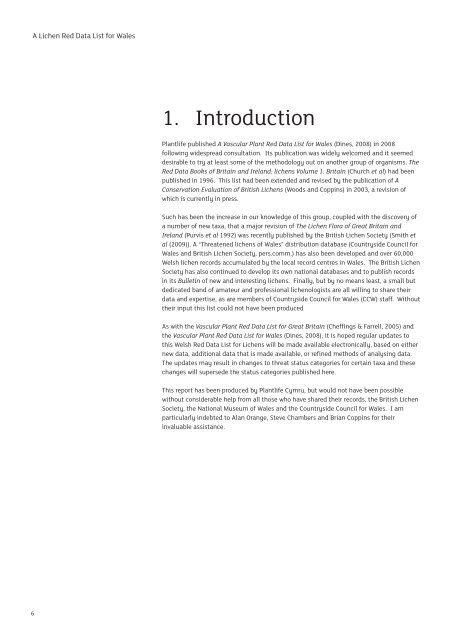Welsh Lichen Red List - Lichens of Wales
Welsh Lichen Red List - Lichens of Wales
Welsh Lichen Red List - Lichens of Wales
You also want an ePaper? Increase the reach of your titles
YUMPU automatically turns print PDFs into web optimized ePapers that Google loves.
A <strong>Lichen</strong> <strong>Red</strong> Data <strong>List</strong> for <strong>Wales</strong><br />
1. Introduction<br />
Plantlife published A Vascular Plant <strong>Red</strong> Data <strong>List</strong> for <strong>Wales</strong> (Dines, 2008) in 2008<br />
following widespread consultation. Its publication was widely welcomed and it seemed<br />
desirable to try at least some <strong>of</strong> the methodology out on another group <strong>of</strong> organisms. The<br />
<strong>Red</strong> Data Books <strong>of</strong> Britain and Ireland: lichens Volume 1: Britain (Church et al) had been<br />
published in 1996. This list had been extended and revised by the publication <strong>of</strong> A<br />
Conservation Evaluation <strong>of</strong> British <strong>Lichen</strong>s (Woods and Coppins) in 2003, a revision <strong>of</strong><br />
which is currently in press.<br />
Such has been the increase in our knowledge <strong>of</strong> this group, coupled with the discovery <strong>of</strong><br />
a number <strong>of</strong> new taxa, that a major revision <strong>of</strong> The <strong>Lichen</strong> Flora <strong>of</strong> Great Britain and<br />
Ireland (Purvis et al 1992) was recently published by the British <strong>Lichen</strong> Society (Smith et<br />
al (2009)). A “Threatened lichens <strong>of</strong> <strong>Wales</strong>” distribution database (Countryside Council for<br />
<strong>Wales</strong> and British <strong>Lichen</strong> Society, pers.comm.) has also been developed and over 60,000<br />
<strong>Welsh</strong> lichen records accumulated by the local record centres in <strong>Wales</strong>. The British <strong>Lichen</strong><br />
Society has also continued to develop its own national databases and to publish records<br />
in its Bulletin <strong>of</strong> new and interesting lichens. Finally, but by no means least, a small but<br />
dedicated band <strong>of</strong> amateur and pr<strong>of</strong>essional lichenologists are all willing to share their<br />
data and expertise, as are members <strong>of</strong> Countryside Council for <strong>Wales</strong> (CCW) staff. Without<br />
their input this list could not have been produced<br />
As with the Vascular Plant <strong>Red</strong> Data <strong>List</strong> for Great Britain (Cheffings & Farrell, 2005) and<br />
the Vascular Plant <strong>Red</strong> Data <strong>List</strong> for <strong>Wales</strong> (Dines, 2008), it is hoped regular updates to<br />
this <strong>Welsh</strong> <strong>Red</strong> Data <strong>List</strong> for <strong>Lichen</strong>s will be made available electronically, based on either<br />
new data, additional data that is made available, or refined methods <strong>of</strong> analysing data.<br />
The updates may result in changes to threat status categories for certain taxa and these<br />
changes will supersede the status categories published here.<br />
This report has been produced by Plantlife Cymru, but would not have been possible<br />
without considerable help from all those who have shared their records, the British <strong>Lichen</strong><br />
Society, the National Museum <strong>of</strong> <strong>Wales</strong> and the Countryside Council for <strong>Wales</strong>. I am<br />
particularly indebted to Alan Orange, Steve Chambers and Brian Coppins for their<br />
invaluable assistance.<br />
6

















